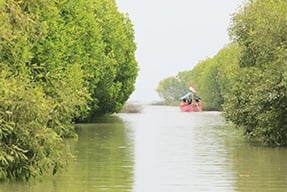Described below is the summary of Q&A session with institutional investors and securities analysts at the FY2011 results conference call held on May 18, 2012.
- Q1For FY2012, your full-year forecast on Tokio Marine & Nichido Financial Life's (TMFL) net income is a loss of ¥19.3 billion. I'd like you to qualify the reason behind it. Also, in considering a decrease in in-force policies going forward, what kind of financial impact should we assume on TMFL's profit on a financial accounting basis?
- A1
The major reasons behind the projected loss are as follows;
i) increased cost of the ceding reinsurance reviewed and contracted in December 2011 is expected to be approximately ¥8 billion* in annual, ii) a recording of extra retirement benefit of ¥2 billion for the purpose of supporting employees' job-changes, iii) additional provision for underwriting reserves of several billions of yen due to technical reasons on accounting rules. However, the amount of additional provision is expected to be smaller to a considerable degree from FY2013 onward.
* On the teleconference, the figure with * mark was explained as ¥5 billion, which was a year-on-year changes between FY2011 results and FY2012 projections. Please note that here on the corporate website, we corrected the figure to the annual reinsurance cost as to the revised program expected to incur in FY2012.
- Q1(2)Do you still expect losses of more than ¥10 billion from FY2013 onward, despite the elimination of ¥2 billion worth extra retirement allowance and the decrease in additional provision of underwriting reserves?
- A1(2)
From FY2013 onward, the degree of net losses is expected to be narrower as in-force policies will be declining.
- Q2You are forecasting an increase in dividends per share at the beginning of the year. Please tell us the reasons behind the increase. And what will be the major factors for continuous increase in dividends per share or conducting share repurchases during the period of the new mid-term business plan?
- A2
One of the major factors for an increase in dividends is that we expect earnings recovery in FY2012. Our top management will explain the policy for return to shareholders from a medium- to long-term perspective at the upcoming IR Conference on May 31.
- Q3Concerning the rise in reinsurance premium rates, how much did you factor these impacts including both ceding and ceded reinsurance into FY2012 consolidated projections of net premiums written?
- A3
We do not expect any material impact on net premiums written due to the changes in the reinsurance market. We are making best efforts to minimize such impacts by adjusting our reinsurance scheme.
- Q4How much increase in premiums did you factor as an effect of sales tie-up with Meiji Yasuda Life?
- A4
On a managerial accounting basis, we expect about ¥9 billion in auto and ¥4 billion* in fire and so on in FY2012.
* In the teleconference, though the figures with * mark were explained as ¥12 billion in auto and ¥3 billion in fire, those were totals of three-year projections during the new mid-term business plan (three years from FY2012 to FY2014). Here, we corrected the figures expected to recognize in FY2012.
- Q5Regarding auto insurance, the loss ratio excluding the effect of natural disasters in FY2011 doesn't seem to have improved YoY. What is the reason behind?
- A5
In FY2011, there was a reversal effect of decreased reported claims in FY2010 due to a temporary decline in traffic volume right after the Great East Japan Earthquake in March 2011. In addition, we also had a greater impact from heavy snowfall than in FY2010. Even these factors being excluded, accident frequency and unit-claim cost slightly rose up YoY. Snowfall is not categorized as natural disaster, so the said loss ratio includes the effect of the heavy snow fall.
- Q6I think a large part of the claims payment for Thai Flood will be executed in FY2012. How much would it affect the reversal of catastrophe loss reserves?
- A6
Concerning Thai Flood, we expect approx. ¥40 billion claims payment at TMNF in FY2012. Since other incurred claims related to natural disasters in FY2011 and FY2012 are assumed to be paid in FY2012, the loss ratio in fire group is estimated to reach a high level even if the impact of Thai Flood is excluded. The estimated reversal amount of catastrophe loss reserve in fire group will be ¥39.8 billion, which could be assumed as impact from Thai Flood.
- Q7Please tell us the amount of net incurred losses related to natural disasters in international insurance business in both FY2011 actual results before the consolidation adjustment, and FY2012 projections respectively.
- A7
FY2011 results were ¥150 billion including Thai Flood losses, and FY2012 projection is ¥25 billion.
- Q8A massive low pressure and tornados happened in Japan at the beginning of the fiscal year. At this point, how much losses have you already recognized related to these disasters out of ¥30 billion for the budget of domestic natural disaster losses in FY2012 projection?
- A8
The massive low pressure caused a loss of ¥7 billion or so in the estimate made at this point. In the meantime, we can not deny the possibility of further development from now on.
- Q9While over ¥100 billion of business-related equities were sold in FY2011, that of FY2012 projections is ¥50 billion. What are the reasons behind this significant decline?
- A9
The reason for the decline in the projection is that we are rather conservative at the beginning of the year, and also we would like to make progress in the business-related equity sales considering the market conditions. Overall, there is no change in our direction that we aim to continue the sales of business-related equity as much as possible.
- Q10Have you factored the impact of the introduction of the new grade rating system for auto insurance in FY2012 projections?
- A10
Yes, we have factored it into our projections. However, though the new grade rating system is scheduled to be introduced in 2H of FY2012, since application of the new grade ratings will be one year later the introduction, it will not until 2H of FY2014 that the new grade ratings will be applied to all policy holders. So, its impact for FY2012 is not significant.
- Q11How would you explain the reason for the year-on-year increase in net losses in auto insurance in FY2012?
- A11
As explained earlier, since FY2011's accident frequency and unit-claim cost slightly rose up YoY in auto, FY2012 projections are based on such trend. Also, since we expect premium increase due to the tie-up with Meiji Yasuda Life, it will increase claim payments as well.
- Q12What is the background of your cancellation of treasury stocks?
- A12
We conduct cancelation of shares in order to sweep away concerns of potential dilution by resale.
- Q13Regarding Delphi, you said its contribution to adjusted earnings will be ¥8 billion this year. How much will its net contribution be on a financial accounting basis including the amortization of goodwill?
- A13
On consolidated basis, since the balance of the goodwill and its amortization period are not finalized yet, the amortization of goodwill is set to be ¥8 billion as provisional figures, so that there will be no impact on P/L.
- Q14If I subtracted dividend payment and EV increases in domestic life insurance business from projected adjusted earnings of ¥165 billion in FY2012, approx. ¥70 billion remains. How would you use this fund? Are there any possibilities of further M&A overseas or share repurchases?
- A14
Our basic policy has been unchanged. That is, we will conduct share repurchases in a flexible manner based on a comprehensive assessment of market conditions, the status of capital and business investment opportunities and other relevant factors.
- Q15Were ¥30 billion net claims paid for Thai Flood in FY2011 mainly on a provisional or fixed basis? If most of them are provisional, I suppose that the projected claim payments of ¥40 billion for this fiscal year may develop until the completion of claim settlement due to interests and changes in loss period. I understand that, however, there will be no impact on the earnings level due to reversal of catastrophe loss reserves. Is my understanding correct?
- A15
Most of the ¥30 billion paid in FY2011 was paid on a provisional basis. However, since our loss estimate includes everything to be expected as outstanding losses, we do not assume that net incurred losses may develop materially at this point.
These information materials are prepared based on the currently available information for us and described subject to our predictions and forecasts carried out at the time of preparation.
It must be noted that what is described therein does not guarantee our future business performance and carries certain risk of misjudgment or uncertainty.
Accordingly, you are kindly requested to bear in mind that there may be a possibility of sizable divergence between the actual business performance in the future and that of our predictions or forecasts described therein.





